

[ SUNDAY TRAVEL ]
3 DAYS IN

DENNIS CALLAN / SPECIAL TO THE STAR-BULLETIN
The Hohensalzburg Fortress, overlooking Salzburg, is likely the biggest and best-preserved medieval castle in Europe. It's 400 feet up but easy to reach on a funicular, an inclined rail car.
Classical City Salzburg is a town of castles, church towers, horse-drawn carriages and alleys lined with cute shops, but its sound is the divine music of favorite son Wolfgang Amadeus Mozart, and yes, the hills are filled with the sound of music.
Old World wonders greet
the eye while the music of
Mozart delights the earDAY 1
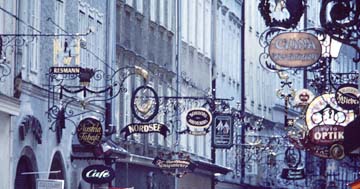
Your first day in Salzburg can be spent on an Old Town walking tour and a castle visit. Shown is Getreidegasse, one of Europe's most interesting pedestrian lanes and the main shopping street of the Old Town. The maze of alleys and courtyards began in the Middle Ages, and the medieval road is still lined with ancient buildings that now house modern shops with antique wrought-iron signs.
DAY 2
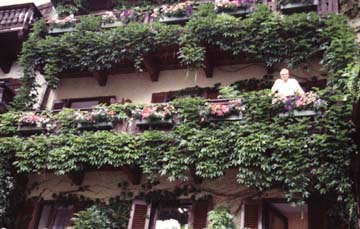
On your second day, visit the Mirabell Gardens, museums, Mozart's home and other points of interest before taking a bus tour of the countryside. Shown is St. Wolfgang, a charming village on Lake Wolfgang that is one of the stops on the Lakes and Mountain half-day tour from Salzburg.
DAY 3
By Dennis Callan
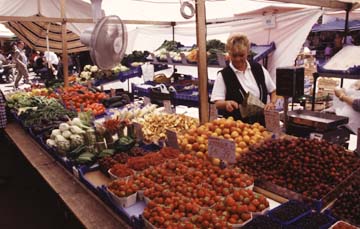
On your final day, churches, museums and points of interest in Salzburg lead your agenda. Or you could take the Sound of Music tour, the Salt Mines tour, the Bavarian Mountain tour or the Eagles Nest tour, which affords grand views of the distant Alps. Shown is the outdoor food market on University Square, a good place to find an inexpensive sausage lunch or fresh fruit. It is open daily but is especially busy on Saturday mornings.
Special to the Star-BulletinSalzburg is a city of serious music. There are always performances, but in July and August the annual Salzburg Festival, one of the world's top music events, takes place.
Nestled in the Alpine foothills of north-central Austria, this cozy town and surrounding areas have much to offer. You would be shortchanging yourself if you took a quick look and left, as so many tour travelers do.
Old Town walking tour and castle visit
The center of town is given over to pedestrians, so plan to do a lot of walking. There is much history to absorb, with museums, castles and palaces, but it is the ambience of the town that is most appealing -- the lanes, courtyards, shops, gardens and little squares are the most rewarding part of the experience.
Start early. You will have the town to yourself until 10 a.m., when the day-trippers arrive.
>> Squares and cathedral: Start at the largest square in the city, the Residenzplatz, flanked by the majestic Salzburg Cathedral and the Residenz Palace, a museum that was once the seat of the bishops. In the center of this square is the Baroque Residenz Fountain, with four marble horses hissing water through their teeth, topped by three levels of marble musclemen spouting more water. Built between 1659 and 1661, it is one of the largest Baroque fountains in the world, and you can capture it on film, framed by the cathedral towers.
Salzburg was founded and nurtured by the Catholic Church and ruled by bishops, so it figures the cathedral should be magnificent. Considered to be the finest early Baroque church north of the Alps, it was built in the early 1600s after a fire destroyed the previous cathedral. Much of the art was added in the following century, resulting in a rich display of ceiling murals, statues and stucco design elements. It was designed by Italian architects, based on the plan of Il Gesu in Rome.
There are real horses in Residenzplatz also, as this is the main station for the traditional Austrian horse carriages, the fiaker.
Just a block away on the edge of the Old Town is Mozartplatz, with a statue of its namesake looking at Café Glockenspiel, where he spent many hours. You might come back to this restaurant later. The best place to dine is on the second floor balcony, with a view over Mozartplatz. American Express has an office on the square if you need to cash travelers checks.
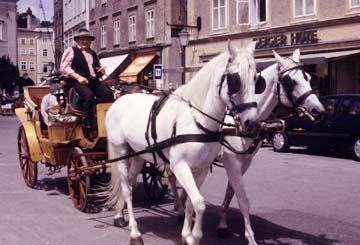
DENNIS CALLAN / SPECIAL TO THE STAR-BULLETIN
You can learn a lot about Salzburg from the stories of the horse-carriage drivers, and a ride in the traditional Austrian "fiaker" is also a nice way to supplement your walking tours.
Mozartplatz leads into Salzburg's most interesting pedestrian lane, running through the heart of the Old Town. This medieval road is lined with ancient buildings containing modern shops, with antique wrought-iron signs jutting from the old facades. Just 600 yards long, it's an easy walk. Starting out as the Judengasse and changing to the Getreidegasse, it is famous as the road Mozart was born on and is also the town's shopping street.
>> Pedestrian lanes: Begin at the Judengasse end, which 500 years ago was the Jewish neighborhood. The lane starts at a small square called Waagplatz, the main square in the Middle Ages. There is a nice cafe here in front of the five-star Hotel Altstadt. This landmark building, now one of Salzburg's best hotels, has been a traveler's inn since 1377. No two rooms are alike. Drop into the old-fashioned lobby for a look around, and peruse the Symphonie Restaurant's gourmet menu.
The lane curves, heading into the Old Town center. There are side streets and covered arcades. A few hundred feet away is the broad square called Altermarkt, the "Old Market." There is another fountain in the center, and among the pastel-colored, stucco facades you will find Café Tomaselli, enjoying its 300th anniversary. Swing back around through Goldgasse and Brodgasse, returning to the main lane, which now changes to Getreidegasse.
>> Getreidegasse: The maze of alleys and courtyards began in the Middle Ages as a row of shops with homes upstairs and little yards in the rear. Later, another strip of buildings was built behind the yards, and these structures grew into each other and formed enclosed courtyards and covered walkways, called "Durchhauser" (through the houses), that serve as today's shopping arcades. Every part of town was handmade, so each building is unique, with very few straight lines or plain surfaces.
The beauty of staying in Salzburg for several days is that you don't have to worry about seeing everything at once. The town takes on a completely different charm in the early evening with the warm glow of twilight and very few people, so come back for more then.
Down the road you will see the Old Town Hall. The small size of this city hall, compared with the massive castle on the hill, shows where the real power lay.
A block down, you will come upon the Mozarts Geburtshaus, birthplace and childhood home of the great composer. It is disappointing because it contains none of its original furniture, but the Mozart lover will enjoy seeing Mozart's childhood violin, his concert violin, his clavichord, pianoforte, portraits and correspondence. A more interesting Mozart site is his house from later years, across the river.
At the end of Getreidegasse is another five-star hotel, the Goldener Hirsch. Like the Altstadt, it has an excellent restaurant.
>> Hohensalzburg Fortress: Don't miss a visit to this citadel, which is claimed to be the largest and best-preserved medieval castle in Europe. It is not enough to just look at it from below its 400-foot cliff perch -- you need to walk through the grounds and go inside.
It's easy to get up the hill because they had the vision, 100 years ago, to build a funicular, an inclined rail car that carries you to the top for about $5 round-trip, which includes access to the castle grounds. Called "Festungsbahn," the lift is one block from the cathedral, along Kapitelplatz, another wide-open space with a fountain of Neptune on a seahorse. You could walk up a meandering zigzag footpath, but you only save $1.50, and it is a major climb.
The steep hilltop is such a natural place for a fort that it was used by the Romans nearly 2,000 years ago. Two choice viewpoints are the Reck watchtower, with a panorama of the Alps to the south, and the Kuenburg bastion with a grand view looking down on the bell towers and Old Town domes.
The existing castle was begun in the 11th century and retains a feeling of the ages. It was built as a refuge for archbishops who sided with the pope in church battles against the princes of South Germany. Construction was finished by the end of the 17th century, with the addition of towers, staterooms, bastions for cannons and barbicans, and the construction of magazines and arms depots.
Hohensalzburg is so big that it feels like you are walking through a medieval village. An interesting perspective is along the inner castle moat, which looks like an ancient cobbled lane, with towers rising above the solid stone walls. This dry moat leads to a salt depot where the precious "white gold" was stored.
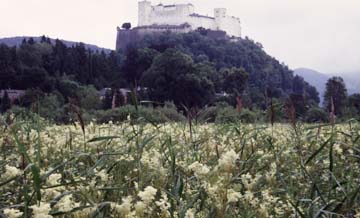
DENNIS CALLAN / SPECIAL TO THE STAR-BULLETIN
Another view of the Hohensalzburg Fortress, which overlooks the city from its perch on a cliff, a natural place for a fort.
Salzburg means "salt city" for a good reason -- the large salt deposits in a nearby mountain were mined for 2,000 years and formed the basis of wealth and trade for this entire region. Before electricity and refrigerators, salt was the primary method of preserving food. Salt is the main reason Salzburg exists, and although the mines closed a hundred years ago, you can still visit them a few miles outside of town.
With cliffs all around and massive fortified walls lined with cannons, the castle was impregnable. With its food warehouse and water well, occupants could withstand any siege. It functioned not only to prevent attacks from outsiders, but also to keep the townspeople at bay in that familiar scenario -- rich rulers on the hill lording over the peasants below. However, the bishops who governed from here were often at each other's throats, and internal intrigue brought down more than one. Even Archbishop Wolf Dietrich, who initiated the lower town's three grandest buildings -- the Salzburg Cathedral, the Residenz and Mirabell Palace -- was deposed and imprisoned in the castle for his final five years due to a dispute with his nephew over salt-mining revenues.
You can see exhibits about the archbishops and the history of the region in the castle museum. A military museum contains suits of armor and ancient weapons. You will also see the Gothic wood carvings and paintings that decorate the Golden Hall and the Golden Chamber. Chamber music concerts take advantage of the excellent acoustics in the Princess Room.
There is a lovely terrace cafe, with a panoramic view across the plain to the mountains. It's a perfect place for local beer, coffee and dessert or a sausage meal.
Town is just a two-minute ride on the funicular. There is a pleasant beer garden, Stieglkeller, just to the right as you get off the funicular.
You can finish the day with a stroll along the Getreidegasse and side alleys. Twilight is the magic hour for photographers. You do not have to be a serious photographer to enjoy the mix of lighting as the sun goes down and the lights come on.
In the evening, Salzburg offers concerts. One I enjoy is the Mozart Dinner Concert in the Stiftskeller at St. Peter, a restaurant founded at the beginning of the ninth century. Musicians in historic costumes perform Mozart pieces while dinner is served by candlelight. Sets of music alternate with traditional courses during this relaxing evening in a beautifully decorated Baroque dining hall.
Mirabell Gardens, museums, points of interest and a bus tour of the countryside
This morning's activities will be on the "Right Bank" of the River Salzach, starting with a lookout that offers a postcard view of the Old Town and castle. This terrace is a short walk from Platzl Square, and you will see the cathedral and town domes across the river, and the castle towering above on a rocky peak. You can descend the same way or walk down Imberstiege staircase to a hidden medieval neighborhood along the Steingasse, a narrow cobblestone alley of great charm.
Return to Linzergasse, an ancient street, and take note of the restaurants serving traditional food. Your next goal is three blocks away, the Mirabell Gardens.
>> Mirabell Gardens: The lovely grounds surrounding the Mirabell Palace were originally laid out in 1689 by the great Austrian architect Fisher von Erlach, but the gardens and palace were redesigned 30 years later by Lukas von Hildebrandt. The manicured flower beds are ablaze with bright reds and yellows that contrast sharply with the expansive green lawns, interspersed with statues and fountains.
Mirabell Palace was built by Wolf Dietrich for his mistress, with whom he had 15 children. The palace was rebuilt over the years. It suffered heavy bombing damage during World War II, but it now looks better than when it was new.
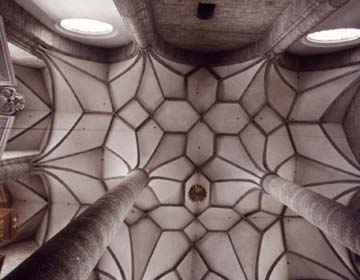
DENNIS CALLAN / SPECIAL TO THE STAR-BULLETIN
Parts of the Franciscan Church date to 1221, making it one of the oldest buildings in town. It represents 600 years of architectural styles, including this impressive Gothic ceiling.
Today the palace is a municipal building, famous for weddings in the grand Marble Hall. If you are here on a weekend, you will see lots of couples and their parties in the gardens. Be sure to walk up the Cherub Staircase, designed in 1723, with marble cherubs lounging along a Baroque banister.
You could also visit Mirabell's little Baroque Museum. The works of art here all belong to the Baroque period of the 17th and 18th centuries, and consist of small models, oil studies and sketches by famous artists such as Bernini, Cortona, Tiepolo, Rubens and Fragonard.
>> Mozart Dwelling House: Located one block from the gardens, this is where Mozart and his family moved when he was 17. It was here that he wrote countless symphonies, serenades, divertimenti and five concerts for violin and piano. Some of these original manuscripts are on display, along with his pianos and original furnishings. It is on Markatplatz, also the site of the Church of the Holy Trinity, another great creation by Fisher von Erlach.
>> Lakes and mountain tour: Many choices are offered for an out-of-town excursion, but a favorite is this one, which leaves from Mirabell Square and brings you into the beautiful countryside of Salzkammergut.
After an hour you arrive at the little village of St. Wolfgang on the shores of Lake Wolfgang, where you can browse, have snacks and visit the Gothic church to see a wooden altar carved by Michael Pacher, a leading woodcarver of the early Renaissance period.
The tour continues with a half-hour boat ride across Lake Wolfgang. The boat docks at the quaint village of St. Gilgen, the home of Mozart's mother and sister.
There is time now to explore on your own, poking around in the Old Town's little alleys and lanes. This evening you might consider a concert in the castle or in the Residenz, with performances by the Mozart Chamber Orchestra of Salzburg.
Churches, museums and points of interest in town, and a choice of day trips
By now you have seen most of Salzburg, except for the churches and museums. If you would rather skip more town sights, you could do two of the half-day tours listed below.
>> Three churches: The beautiful cemetery of St. Peter is one of Europe's oldest active burial grounds. This cloistered garden, nestled against the side of the Monchsberg cliff, has beautifully maintained plots.
Inside St. Peter's Church you will find one of the most elaborately decorated interiors in town, presenting the Baroque period in full flower. There is a mix of architectural styles in this church that started as a Romanesque basilica in the 13th century and has evolved with the addition of statues, murals and architectural details that reflect the High Baroque. Mozart played the large organ occasionally, and premiered his "Mass in C Minor" here.
One block over is the Franciscan ("Franziskaner") Church, one of the oldest buildings in town. Parts of it date to 1221, then 300 years later, a Gothic choir was added, joined 200 years later by some Baroque elements, including the main altar by Fisher von Erlach. This church represents 600 years of architecture spanning the early Middle Ages to the Baroque period.
A block away at Universitatsplatz is the Collegiate Church, also designed by von Erlach. It is his most important work in Salzburg.
If you are churched out, you could skip the interior -- which is mostly notable because of its great size -- and look around University Square, bustling with an outdoor food market. But if you take a short walk to the Cafe Winkler, you can get a table with a view, on a hill overlooking the city.
>> Cafe Winkler: To get up to this famous terrace, walk to Sigmundsplatz, where you will see a fountain called the Horse Trough, a drinking pool for horses. Keep going along Gstattengasse until you see the Monchsberg Lift sign. The Cafe Winkler is so high on the cliff that you have to pay $1.50 for an elevator ride to get there, but the stunning view of town with the castle rising in the background makes it worthwhile. The only casino in town is also up here.
Nature lovers can stroll on a path overlooking town, through the woods to the castle, then go down by funicular.
You could keep busy touring museums and doing more strolling in the Old Town, or take a half-day bus tour, or add another day to your stay to enjoy the following options.
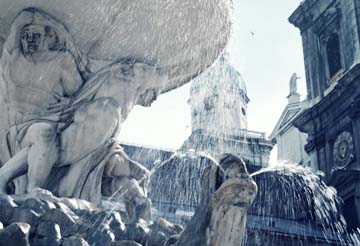
DENNIS CALLAN / SPECIAL TO THE STAR-BULLETIN
Residenz Fountain, built in the mid-17th century, is one of the largest Baroque fountains in the world. It features a dramatic scene of four marble horses spouting water, topped by three levels of marble musclemen spouting more water.
>> Museums and palaces: Located near the bottom of the Winkler's elevator is the Natural History Museum, which has 80 exhibition rooms devoted to nature, from outer space to local insects. Exhibits utilize realistic dioramas and interactive and audio-visual technology. The museum also has one of the best aquariums in Central Europe. The culture and history Museum of Salzburg is next door, with displays documenting the area from its beginnings.
For art lovers, there is the Residenz, former seat of Salzburg's archbishop, elaborately furnished in styles of the Renaissance and the Baroque, with illusionist ceiling murals, and masterpieces by Rembrandt, Rubens, Brueghel and others. It takes about an hour to see the palace and the museum in a self-guided visit that can be enhanced by the audio guide.
Or how about a beer museum? Stiegl's Brauwelt shows you how beer is brewed, and your admission charge includes a taste. It's at 9 Brauhausstrasse.
Hellbrun Palace is a major attraction a few miles outside town. The easiest way to get there is by taxi. It is famous for its Surprise Fountains, which soaked the guests of the mischievous prince-bishop who built the complex in 1613-15. The trick fountains still operate, so be careful as you walk through the gardens. Other kinetic garden displays include a mechanical theater and water organ, powered by gravity-fed hydraulics. Several rooms have 3-D murals covering walls and ceilings in the trompe l'oeil style.
If you would rather spend this final afternoon on an organized tour, there are several excellent choices
>> Sound of Music Tour: It runs twice daily and lasts four hours for $30. This takes you to many of the sites used in the movie. It begins at the Mirabell Gardens, as seen in the Do Re Mi song where Maria and the children danced around the statue of Pegasus. It continues to Nonnberg Abbey, Anif Castle, the Mondsee wedding church and Castle Leopoldskron, featured as the Von Trapp home in the movie.
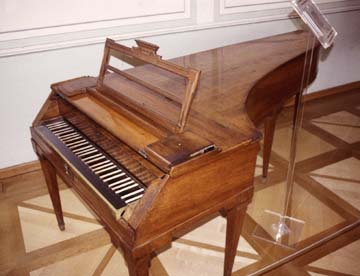
DENNIS CALLAN / SPECIAL TO THE STAR-BULLETIN
Mozart's Geburtshaus, the birthplace and childhood home of composer Wolfgang Amadeus Mozart, has some of his musical instruments, portraits and correspondence on display.
>> Bavarian Mountain Tour: 2 p.m., $30, or Eagles Nest Tour: 9 a.m., $40. This tour brings you into 6,000-foot high peaks for grand views of the distant Alps along the Königseeache, through the lovely valley and picturesque farmland to Unterau and Obersalzberg.
>> Salt Mines Tour: Includes a cable-car ride to the top of Mount Durnberg, with a reconstructed Celtic village and the oldest salt mines in the world, which you enter by train and continue by boat across an underground lake. The drive includes views across the snowcapped peaks of the Bavarian Mountains and a stop in Berchesgaden.
Here are some places to stay and a few entertainment options in Salzburg, along with Web sites for further research. Prefix all phone and fax numbers with 011-43. IF YOU GO
Hotels
>> Our favorite: Hotel Kassererbrau, 33 Kaigasse, Salzburg A-5010, phone 662-842-406, fax 662-842-44551; e-mail kasererbraeu@salzburginfo.>> Hotel Altstadt, 15 Judengasse, Salzburg A-5020, phone 662-848-5710; fax 662-848-5716; e-mail Radisson-altstadt@austria-trend.
>> Hotel Goldener Hirsch, 37 Getreidegasse, Salzburg A-5020, phone 662-8084; fax 662-843349; e-mail Antonia_Schober@ ittsheraton.com.
>> Osterreichischer Hof, 5 Schwarzstrasse, Salzburg A-5020, phone 662-88-9770; fax 662-88-977551; e-mail oesterr.hof@salzburginfo.
>> Gablerbrau, 9 Linzer Gasse, Salzburg, phone 662-88965; fax 662-88-96555; e-mail gablerbraeu@salzburginfo.
Music
>> "The Sound of Music" dinner show: At the Sternbrau Restaurant, 34 Getreidegasse in the historic heart of town. Admission of $40 includes dinner, starting from 7:30 p.m., and the 8:30 p.m. show. Reserve at 43-662-826617.>> Mozart dinner concert: At Stiftskeller Baroque Hall, St. Peter, 8 p.m.; $60 includes meal, wine and music. Call 43-662-8286.
>> Salzburger Festungskonzerte: Evening concerts in the castle and the Residenz are $30 reserved, $22 unreserved. Can be combined with a dinner offer. Call 43-662-825858.
>> Lunch concert: Listen to the Mozart String Quartet, 1 p.m. Fridays in the Gothic Hall of St. Blasius Church, at the end of Getreidegasse; $20 includes light lunch buffet.
Salzburg Web sites
>> www.salzburginfo.com
>> www.salzburg-burgen.com
>> www.panoramatours.com
>> www.salzburg-sightseeing.com
>> www.mozartfestival.com
>> www.salzburgfestival.com
>> www.salzburg.nethotels.com/english
>> www.mozartserenaden.com